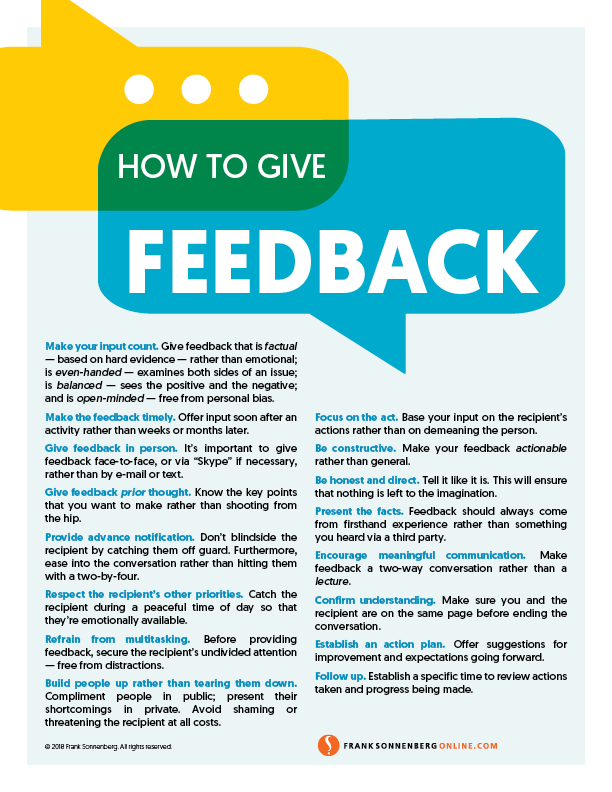
How to Give Feedback
Feedback should be welcomed rather than feared. In fact, we should thank folks who make the effort to nurture us with their valuable input –– even if it hurts at times. Here is how to give feedback:
Make your input count. Give feedback that is factual –– based on hard evidence — rather than emotional; is even-handed –– examines both sides of an issue; is balanced –– sees the positive and the negative; and is open-minded –– free from personal bias.
Make the feedback timely. Offer input soon after an activity rather than weeks or months later. This will ensure that the feedback is relevant and helpful.
Give feedback in person. Input doesn’t have to be formal, but it should be made a priority. For that reason, it’s important to give feedback face-to-face, or via “Skype” if necessary, rather than by e-mail or text. This will enhance communication by providing a more personal and immediate two-way dialog and will enable each party to gauge the other’s body language.
Give feedback prior thought. Know the key points that you want to make rather than shooting from the hip.
Provide advance notification. Don’t blindside the recipient by catching them off guard. Furthermore, ease into the conversation rather than hitting them with a two-by-four.
Respect the recipient’s other priorities. Catch the recipient during a peaceful time of day so that they’re emotionally available. Remember, being present is not the same as being there.
Refrain from multitasking. Before providing feedback, secure the recipient’s undivided attention –– free from distractions.
Build people up rather than tearing them down. Compliment people in public; present their shortcomings in private. Avoid shaming or threatening the recipient at all costs.
Focus on the act. Base your input on the recipient’s actions rather than on demeaning the person.
Be constructive. Make your feedback actionable rather than general.
Be honest and direct. Tell it like it is. This will ensure that nothing is left to the imagination. Furthermore, if your feedback is always glowing, compliments will be less credible.
Present the facts. Feedback should always come from firsthand experience rather than something you heard via a third party.
Encourage meaningful communication. Make feedback a two-way conversation rather than a lecture. Furthermore, the reviewer and recipient must communicate with each other rather than just taking turns talking. And — please give the recipient ample time to respond.
Confirm understanding. Make sure you and the recipient are on the same page before ending the conversation.
Establish an action plan. Offer suggestions for improvement and expectations going forward.
Follow up. Establish a specific time to review actions taken and progress being made.
Do You Know How to Give Feedback?
Please leave a comment and tell us what you think or share it with someone who can benefit from the information.
Additional Reading:
How to Let It Go and Delegate More Effectively
7 Steps to Go from Brutally Blunt to Helpfully Honest
How to Destroy Creativity and Innovation
Do You Promote Excellence?
Are You in Danger of Becoming Complacent?
If you like this article, subscribe to our blog so that you don’t miss a single post. Get future posts by RSS feed, email or Facebook. It’s FREE.





This article was really insightful! I appreciate that it’s clear and practical, something I can always come back to. I especially liked the point about being strategic with timing, balance, and being mindful of the headspace of the person you’re giving feedback to. I feel this is often overlooked, since people tend to focus more on making their point rather than considering whether the other person is actually able to intake and digest it in that moment.
Some people use feedback as a power trip—criticizing to cut others down rather than helping them grow. That’s why I really liked your takeaway, Liz. You highlighted the importance of timing, balance, and being mindful of someone’s headspace—things that actually make feedback constructive instead of destructive.
Thanks for taking the time to write.
Best,
Frank
As I have gotten older, I have realized how important feedback truly is. While some people may view it is something that is meant to bring them down, I view it as something that makes me better. I will be sure to come back to this list of how to give feedback to make sure I do it in the most effective manner possible.
Hi Rylee
I love your perspective. Seeing feedback as a tool for growth rather than criticism is such a powerful mindset. I’m glad you found the list helpful, and I hope it will help you give feedback that truly matters.
Thanks for taking the time to write.
Best,
Frank
I found it very interesting how you broke this down. Feedback isn’t just about pointing out flaws, it’s about timing, delivery, and creating space for genuine two-way communication. Too often we forget that when and how we give feedback matters just as much as what we say. The reminder to focus on actions instead of the person is simple but powerful. Done right, feedback becomes less of a critique and more of a tool for growth.
Hi Michael
I really appreciate your insight. You captured the essence of effective feedback perfectly—how timing, delivery, and focusing on actions make it a tool for growth rather than criticism. It’s a great reminder that feedback isn’t just what you say, but how you say it.
Thanks for taking the time to write.
Best,
Frank